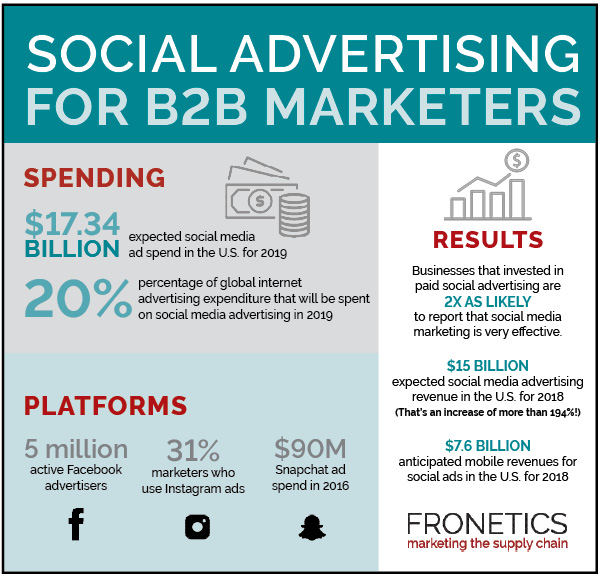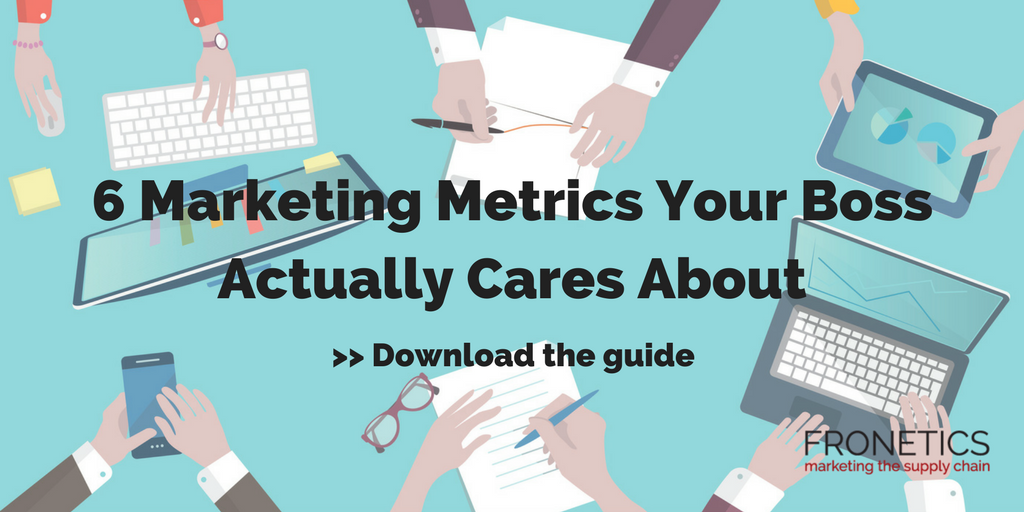
by Fronetics | Jun 7, 2018 | Blog, Content Marketing, Logistics, Marketing, Social Media, Supply Chain
Supply chain and logistics marketers need to incorporate social advertising into their content market strategy (and budget) to stay on top of marketing’s biggest driver.
The way audiences use social media channels is constantly changing. As marketers, we need to make sure we’re adapting to these changes. One of the biggest changes we’ve seen so far in 2018 is the increased use of social advertising.
Social advertising is a paid form of paid digital advertising on social media platforms. For example, the advertising platforms provided by Google, Twitter, and Facebook involve “targeting and presenting ads based on relationships articulated on those same services.” Oftentimes, social advertising is one part of a larger marketing strategy.
Sounds easy enough to implement, right? Well, there are so many options and so many more users. If you’re taking the time and money to invest in social advertising, you need to ensure that you’re using the right platforms and getting in front of your target audiences.
[bctt tweet=”With over 3.5 billion internet users worldwide, it’s easy to see the reach ads on social media platforms can have. Facebook alone has over 2 billion daily active users. 2 billion! ” username=”Fronetics”]
In Social Media Examiner’s new report, it’s hard to dispute that social advertising is anything but powerful. With over 3.5 billion internet users worldwide, it’s easy to see the reach ads on social media platforms can have. Facebook alone has over 2 billion daily active users. 2 billion! That’s a lot of opportunities for distributing your content and gaining new followers.
Here are some powerful statistics to prove the weight of social advertising and why it’s worth your time and pennies.
Infographic: A look at social advertising for B2B marketers

(Made with Canva)
Key takeaway
For the first time in years, Social Media Examiner’s report revealed that marketers are more focused on lead generation than cultivating a loyal fan base. What does this mean for you? The focus has shifted from engagement to metrics and automation.
As marketers, we need to watch for increased use of chatbots and other marketing automation tools that can help supply chain marketers become more efficient and more successful in earning and converting leads.
Related posts:

SaveSave
SaveSave

by Fronetics | Jun 6, 2018 | Blog, Content Marketing, Leadership, Logistics, Marketing, Supply Chain, Talent
Organizations that promote corporate social responsibility (CSR) are reaping the benefits of their good deeds, including increased brand awareness and employee satisfaction.
Corporate social responsibility is a hot topic these days. Generally speaking, it’s a pretty broad term to describe how a company is working to improve its community. Companies can demonstrate CSR in lots of different ways, including donations, employee volunteering, implementing environmentally safe processes, and more.
These efforts, whether large or small, say a lot about your organization. Companies that consistently demonstrate their commitment to CSR initiatives are recognizing their ability to help their community and acting on that knowledge.
[bctt tweet=”55% of consumers are willing to pay more for products from socially responsible companies.” username=”Fronetics”]
And the public is taking notice. 55% of consumers are willing to pay more for products from socially responsible companies. What does that mean for you? It means that corporate social responsibility is as good for your community as it is for your own brand.
Here are four major benefits of corporate social responsibility.
4 benefits of corporate social responsibility.
1. Increased employee satisfaction
The way a company treats its community says a lot about how a company treats its employees. People that feel respected and supported in their jobs are often more productive and satisfied at work. Giving your employees opportunities to volunteer, especially during working hours, creates a sense of community within your organization, as well as a connection to the surrounding community. Employees will gain motivation and pride in their work through these personal-development opportunities.
Employees that are actively involved in the community are also acting as brand ambassadors. The more engaged and invested they are in your organization, and the greater community, the more productive they will be. In fact, companies with highly engaged employees saw 21% better business profitability. What could be better than happy employees promoting your brand while helping their neighbors?
2. Improved public image
In today’s digital era, companies that demonstrate corporate social responsibility are gaining exposure — and praise — for their involvements. Your brand’s reputation can only benefit from good deeds in your community. Think about it: Consumers feel good when they buy products and services from companies that are helping their community.
Don’t miss the opportunity to publicize your CSR initiatives and spread the word about your community involvement. Tweet, post, and share your social programs. Letting the public know about your good deeds will only work to increase your brand’s public image.
3. Increased customer loyalty
In a 2016 Neilson survey, 56% of participants said “a brand being known for its social value” was a top purchasing driver. And 53% of participants said “a brand with community commitment” was a leading purchasing driver.
Customers are more likely to be loyal to your brand if your corporate values align with their personal ones. What’s more, millennials — the largest population, over baby boomers, by 2019 — are driving the market these days. According to Forbes contributor Sarah Landrum, millennials prefer to do business with “corporations and brands with pro-social messages, sustainable manufacturing methods, and ethical business standards.” CSR programs work to showcase your corporate values and demonstrate that team work, community involvement, and engagement are at the top of your core values.
4. Increased creativity
Want your employees to start thinking outside of the box? Want to increase innovation in your company? CSR initiatives encourage your employees to try new things and get re-energized about their jobs.
Through this social involvement, employees will feel empowered to start contributing to the bigger picture. They might come up with new ideas about products or internal processes or innovate new problem-solving solutions. When you demonstrate your company’s values and passions through community giving, employees will feel encouraged (and supported) to develop new and better ways to do their jobs.
CSR is a win/win.
A commitment to corporate social responsibility is no longer optional. Companies need to understand that CSR affects their internal (employee engagement, productivity, turnover rate) and external (increased sales, customer loyalty, brand awareness) growth. By creating and participating in CSR initiatives, companies have the opportunity showcase their core values and create trust among your employees and your buyers.
What corporate social responsibility initiatives have you implemented?
Related posts:

SaveSave

by Fronetics | May 21, 2018 | Blog, Logistics, Strategy, Supply Chain, Talent
Millennial talent seeks employment opportunities with companies that promote transparency, technology, excellence, and social change.
We write often about the supply chain talent gap and how supply chain companies should be proactively recruiting millennials to join their companies. So a recent Harvard Business Review article, which talks about how companies that “young people find dull” (like electrical distributors and manufacturers) can make their businesses seem “cool,” seemed particularly relevant.
While we adamantly disagree that the supply chain isn’t cool, we do think it’s important that logistics and supply chain companies think strategically about recruiting millennial talent.
Millennial talent and the vision thing
According to a new study by strategy firm Department26, “Transparency is the millennial standard operating procedure in the workplace.” Honesty and security are top of mind for this generation that came of age just as the country plunged into The Great Recession.
[bctt tweet=”Beer kegs and ping pong are nice, but millennials are more impressed with leadership that sets goals and delivers on them. ” username=”Fronetics”]
Beer kegs and ping pong are nice, but millennials are more impressed with leadership that sets goals and delivers on them. They want to know how their role contributes to the organization’s success, and they want to know the effort they’re putting into a job is worth it.
“Setting them up for success means regular check-ins, both positive and constructive feedback as a rule, and structured mentorship,” write the authors of the Department26 study.
People say millennial talent doesn’t work for money, and it’s true that they’re not motivated by salary alone. Younger employees want meaningful work that enhances their personal growth.
They also want flexible work rules that show an employer respects and trusts them. Sharing details of your strategic plan or examples of how your HR policies reward personal initiative can help millennial talent see your “boring” business in a new way.
“The thought of not being granted flexibility in exchange for hitting performance metrics is absurd to millennials, and it’s a concept that’s diametrically opposed to the freedom they crave,” the study concludes.
Talk tech
Logistics or trucking can sound dull to the iPhone generation — until you paint a picture of forward momentum and innovation that might surprise them.
Automation, robotics, autonomous vehicles, blockchain, drones and the Internet of Things (IoT) are reshaping the industry. Companies like Amazon, Pfizer and Wal-Mart are experimenting with new technologies to reduce costs, boost productivity, and improve handling performance.
“Wearable technology could soon become a standard must-have in the logistics industry,” according to a recent story in The Business Journals. “As these technologies continue to carve out their role in the global logistics industry, we’re likely to see previously unimagined levels of optimization — from manufacturing to warehousing to delivery.”
Find ways to change hearts and minds by exposing young people to the realities of today’s supply chain. If they think it’s boring, it’s because they really don’t know what it is.
Be the best damn supply chain company anywhere
People want to work for “the best” — the most innovative, the most profitable, or the most admired brand — in every industry. Workers are proud to say they work for a company recognized as being the best at what it does because it says they’re the best, too.
Even millennial talent that has never thought about a career in logistics might reconsider if they’re being recruited by an industry leader.
Celebrate excellence at your company. Promote the awards you’ve won. Share customer testimonials, positive media coverage, and community recognition with prospective recruits.
It also helps to do well by doing good. This is a generation that trusts business, not government, to create positive social change. “Millennials are hungry for a work culture that inspires them. At a macro level, companies should communicate clear plans that reflect their core values,” says Department26.
HBR author Bill Taylor summarizes these sentiments well: “What [millennials] value is the chance to join companies that make a difference and where the work brings out the best in them.”
How is your company recruiting millennial talent?
Related posts:


by Fronetics | May 9, 2018 | Blog, Content Marketing, Logistics, Marketing, Strategy, Supply Chain
A webinar is an excellent content medium to generate leads to or nurture those already in your sales funnel.
Maybe you’ve taken a webinar to enhance your professional skills. Did you know that webinars can be beneficial not only to the students, but also to the business providing them?
In content marketing, we consider a webinar content that your target audience will find valuable. You can leverage this value to move them through the buyer’s journey — whether it’s becoming a lead by providing their contact information in exchange for attendance, or by using the webinar strategically in the lead-nurturing process.
What content should I use in my webinar?
In a recent interview, Amy Porterfield, online marketing expert and the host of Online Marketing Made Easy Podcast, shares her ideas about what content should be part of a webinar and what webinars should sell.
[bctt tweet=”“Webinars are ideal when you’re selling knowledge. The product allows someone to continue learning in a medium that’s similar to the webinar itself.” Amy Porterfield” username=”Fronetics”]
Porterfield suggests that live online workshops and pre-recorded courses sell well in a webinar, whereas physical products are less effectively sold in this format. “So before you choose a webinar to sell your product or service, think about how the thing you’re selling is or isn’t like a webinar experience.”
How is a webinar different from my other content?
What separates your free content (like blogs, social media, podcasts, etc.) from paid content like a webinar?
Porterfield emphasizes that, while free content explains the “What” of your products and services, “your paid content explains the How.” She suggests that a successful webinar will “paint a picture using images and really powerful words and stories.”
Your attendees should leave the webinar feeling that they’ve learned something valuable, and that they are ready to take the next step — which should be considering your product or services. “When you begin selling in your webinar, focus on how your paid program, online product, consulting, or coaching helps attendees achieve the opportunity, transformation, or result you’ve just explained,” says Porterfield.
She also suggests bringing your target audience’s obstacles to the forefront of the conversation. “Clearly articulating the obstacles lets your audience understand them on your terms and creates a well-defined pathway for your product or service to help them overcome the obstacles. Essentially, you want to provide enough information so that your product is the next logical step.”
Have you tried creating a webinar?
Related posts:


by Fronetics | May 2, 2018 | Blog, Content Marketing, Customer Service, Logistics, Marketing, Social Media, Strategy, Supply Chain
A new study shows that businesses that reply to customer reviews receive better ratings overall than those that do not respond.
I’ve written before about the rising popularity of B2B user review sites and how supply chain and logistics businesses can use them to increase organic traffic and lead-to-sale conversion rates. B2B buyers are increasingly considering user reviews when making purchasing decisions. That’s great for business — when the reviews are good.
But what if you get bad reviews?
[bctt tweet=”Bad reviews don’t necessarily spell disaster — but they do mean that you should incorporate a response plan into your overall marketing strategy. ” username=”Fronetics”]
A brand new study published in the Harvard Business Review (HBR) shows that businesses that reply to customer reviews get better ratings overall. This means that bad reviews don’t necessarily spell disaster — but they do mean that you should incorporate a response plan into your overall marketing strategy.
Replying to reviews is an important part of online reputation management — which is especially crucial in the B2B space, where companies live and die by their reputation. So how does responding to reviews improve your online reputation?
A study in why to reply to customer reviews
To examine this question, Professors Davide Proserpio and Giorgos Zervas looked at tens of thousands of hotel reviews and responses from TripAdvisor. What they found was that “when hotels start responding, they receive 12% more reviews and their ratings increase, on average, by 0.12 stars.”
While 0.12 may not seem like a lot, in the scale of TripAdvisor’s 5 star system, where ratings are rounded to the nearest half star, it has a significant impact on customers’ perceptions.
Proserpio and Zervas found that “approximately one-third of the hotels we studied increased their rounded ratings by half a star or more within six months of their first management response.”
Improved ratings are related to management response
So why is it that the hotels started to get more and better reviews when management started responding?
The researchers examined every facet of the data to rule out other factors that would undermine causality, and found that in fact “improved ratings can be directly linked to management responses,” rather than improvements made to facilities or services.
To explain it, the researchers make the analogy of eating at your favorite restaurant and your meal arrives late. You complain to your dinner companions, but when the manager checks in seconds later and asks how everything is, “for a moment, you consider complaining, but instead choose to avoid confrontation and focus on enjoying the rest of your meal.”
Essentially, by humanizing your presence on review sites, you discourage potentially awkward online interactions.
The researchers conclude, “While negative reviews are unavoidable, our work shows that managers can actively participate in shaping their firms’ online reputations. By monitoring and responding to reviews, a manager can make sure that when negative reviews come in — as they inevitably will — they can respond constructively and maybe even raise their firm’s rating along the way.”
Do you always reply to customer reviews on user review sites?
Related posts:










